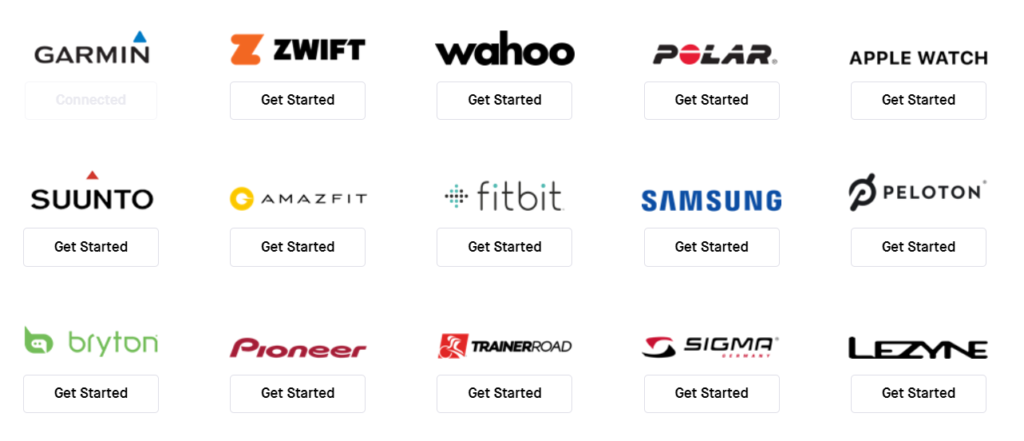Introduction
Continuing from my blog last week that explored the basics of Fitness Data, I am exploring how ‘open’ the exchange of data is between vendors and aggregators.
There are several hardware vendors in the market with dominant positions, each of which has a ‘sticky’ ecosystem that is designed to keep a customer engaged and using there products or data services, instead of migrating to another provider when the next piece of sexy hardware comes along. The following are some of them at the time of writing:
- Apple
- ANT
- FitBit
- Garmin
- Huawei
- Samsung
- Xiaomi
I have not differentiated between activity trackers, sports trackers, smart watches, etc. as my interest is in data acquired and how it can be aggregated, shared or moved.
I contend that the holy grail for Fitness Data is ultimately going to be aggregation, which given the disparate ecosystems, is dependent on
- Open standards (formal or informal)
- Programmatic integration
- Business models where sharing data makes commercial sense
So lets take a look …
File Formats
The simplest method for sharing is the exchange of files, the following are some of the more popular formats that facilitate the exporting and importing of data.
Comma Separated Variable (CSV)
CSV can be considered as the simplest of all the file formats and is easy to read but has none of the structural advantages of the alternative file formats like TCX.
GPS Exchange Format (GPX)
GPX is an open XML schema for software applications to exchange data to describe way-points, tracks, and routes.
Flexible and Interoperable Data Transfer (FIT)
FIT is a file format used for GPS where data is stored in a binary file format. Used by newer Garmin and ANT devices, it is designed to be compact, interoperable and extensible
Training Center XML (TCX)
TCX is an XML schema created by Garmin and includes not only way-points but additional data with like heart rate, cadence, etc. as well as a user defined data.

XLS and XLSX
XLS and XLSX are formats inherited from Excel spreadsheets. They have few of the structural advantages of the alternative file formats like TCX, even though XLSX is XML based.
A summary of the file formats supported by some of the vendors is as follows:
| Vendor | Import | Export |
|---|---|---|
| Runkeeper | GPX, TCX | GPX |
| Garmin | TCX, FIT, GPX, XLS, XLSX, CSV | FIT, GPX, TCX, CSV, Google Earth |
| Strava | TCX, FIT, GPX | GPX, TCX |
| FitBit | – | CSV, XLSX |
Application Program Interface
As mentioned before, we can consider the export and import of files as being the most basic form of integration. This is most commonly used by individuals who are prepared to spend a few hours to:
- Choose a file format that is supported by the source vendor and the target vendor (e.g. TCX).
- Log onto the source vendors website.
- Export their files in the chosen format.
- Log onto the target vendors website.
- Import the files to the target vendor.
However there is a far more elegant, repeatable and reliable approach available via the use of an API. Conceptually the approach is the same but done programmatically. The following are the discrete steps required to upload data via a Strava API as an example:
Setup
- Register your app via the Strava site.
- Locate the access token created as part of the registering process
Operate
- Make a request to the chosen API (POST https://www.strava.com/api/v3/uploads) and provide the necessary arguments, including the access token and the FIT, TCX or GPX file.
With API integration widely available, we can see from the Strava screen shot the broad options available to users when exchanging their data and consequently the advantages to aggregators to facilitate this exchange for free:

Types of Vendors
Before I finish it is worth categorizing the four types of vendors who participate in data sharing:
- Hardware manufacturers (Apple, Garmin, ANT etc.)
- Aggregators (Strava, Endomondo) who rely on a free to premium model where limited functionality is a available for free but the user needs to subscribe if they wish to use more than basic feature.
- Integrators who generate revenue by moving data between vendors (FitToFit)
- App builders who rely on the GPS hardware of a smart device (e.g. Runkeeper on a iPhone)
Summary
Before writing this I had assumed that hardware vendors would be fighting to keep the data ‘Genie in the Bottle’ but it appears that it is well and truly out. We have now have freemium aggregators who provide a one stop shop for a user who may have multiple fitness trackers from different vendors
Given there is no longer a technology obstacle to openness, we are faced with the conclusion that it is now a data privacy decision in the hands off the individual user where they will need to weigh up what they are relinquishing when they take up the aggregator’s offer to relieve them of their data burden.


